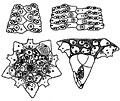The Echinoid Directory
Asthenosoma Grube, 1868, p. 42
[= Cyanosoma Sarasin, 1886, p. 80, type species C. urens Sarsin, p. 80 (=A. varium Grube, 1868), subjective ]
| Diagnostic Features |
|
|---|---|
| Distribution | Recent, Indo-Pacific and Caribbean. |
| Name gender | neuter |
| Type | Asthenosoma varium Grube, 1868, by original designation. |
| Species Included |
|
| Classification and/or Status |
|
| Remarks |
|


